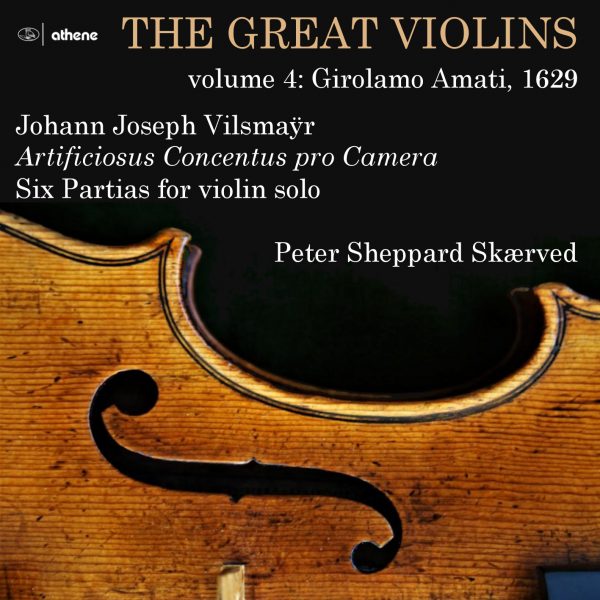Infodad
Sound quality is a major attraction on a new Athene disc featuring just about the only surviving music by Johann Joseph Vilsmaÿr (1663-1722): a very extensive (more than 80-minute) set of six Partias (partitas) that date to Bach’s time (1715) and stand as a little-known early example of the Baroque dance suite. There is some uncertainty about their instrumentation: their full title ends with the words Con Basso Belle imitante, which could mean they were written for violin and basso continuo or could mean they were intended for solo violin incorporating textures resembling those of a basso. Either way, the bass part – if it existed – has been lost, and Peter Sheppard Skærved plays the pieces strictly on a violin.
And what a violin it is: a 1629 instrument by Girolamo Amati (1561-1630), with the warmth and splendidly even tone for which Amati instruments have long been renowned. This disc is actually the fourth in a series focusing on specific great violins, the first three having featured a 1570 Andrea Amati, a 1647 Niccolò Amati, and a 1685 Antonio Stradivari. As an inevitable result, the focus here is as much on the instrument as on the performer and the music being played. The music is nevertheless very worthwhile indeed. The Partias begin and end with works in A, with the sequence between those bookends being B-flat, C minor, D, and G minor. Although not connected thematically, the six pieces are parallel examples of the dance-suite form, and all of them are very finely made and quite challenging to perform.
Unlike the more-familiar solo-string works of Bach, Vilsmaÿr’s are collections of pieces that are very brief indeed, often less than a minute apiece. The first and second partias include 10 movements each; the third and fourth have nine each; the fifth has eight; and the sixth contains 10. The dance forms will be familiar to listeners who know Baroque suites, although some spellings are slight variants of the usual ones: saraband, gavott, menuett, passpied, ciaccona, rigodon, guique, and so forth. The fourth suite contains a dance form about which nothing substantive is known, labeled brunada, and the third includes a highly emotional Aria Lamentevole that is one of the distinct highlights of all the partias.
Aside from this one movement, little in these works is particularly substantial, yet taken as a whole, they exhibit a degree of seriousness that takes them beyond the “salon music” of their time into a realm with a greater sense of drama. It is especially noteworthy – and has a great deal to do with the sound of these works – that the six partias call for the violin to be tuned four different ways. The tunings result in tone that ranges from quite dark (the C minor partia) to very bright (the D major).
Skærved is more than a virtuoso performer of these works: he is a guide for listeners to music with which they will likely be unfamiliar, and a guide as well to the marvelous capabilities of an absolutely top-notch violin that dates to more or less the same time as the music heard on this exceptionally interesting CD.
@divineartrecordingsgroup
A First Inversion Company
Registered Office:
176-178 Pontefract Road, Cudworth, Barnsley S72 8BE
+44 1226 596703
Fort Worth, TX 76110
+1.682.233.4978











![Listen to the full suite of Marcel Dupré’s Variations Sur un Noël, Op. 20 from Alexander Ffinch’s #Expectations release today! listn.fm/expectations [in bio]](https://scontent-dfw5-1.cdninstagram.com/v/t51.71878-15/588904367_2327488161082898_8709236950834211856_n.jpg?stp=dst-jpg_e35_tt6&_nc_cat=105&ccb=7-5&_nc_sid=18de74&efg=eyJlZmdfdGFnIjoiQ0xJUFMuYmVzdF9pbWFnZV91cmxnZW4uQzMifQ%3D%3D&_nc_ohc=BGoHgV_YYfIQ7kNvwHaEWWD&_nc_oc=Adnavy1XXPsySG9ucjtfudLjjHIdSeRMyt7Emd3nd1e5rZg4Zrj1WDqMfjt9iXen-Sd_Yp87jwT1h-Cr1RI5Hpaj&_nc_zt=23&_nc_ht=scontent-dfw5-1.cdninstagram.com&edm=ANo9K5cEAAAA&_nc_gid=uiHS7atAeSBHTiBFgf2WIA&oh=00_AfoMFJBd3lveh4hoIcKs98jbi5EvJSUeU-YV6zAN7DsdHg&oe=695DFAEA)
